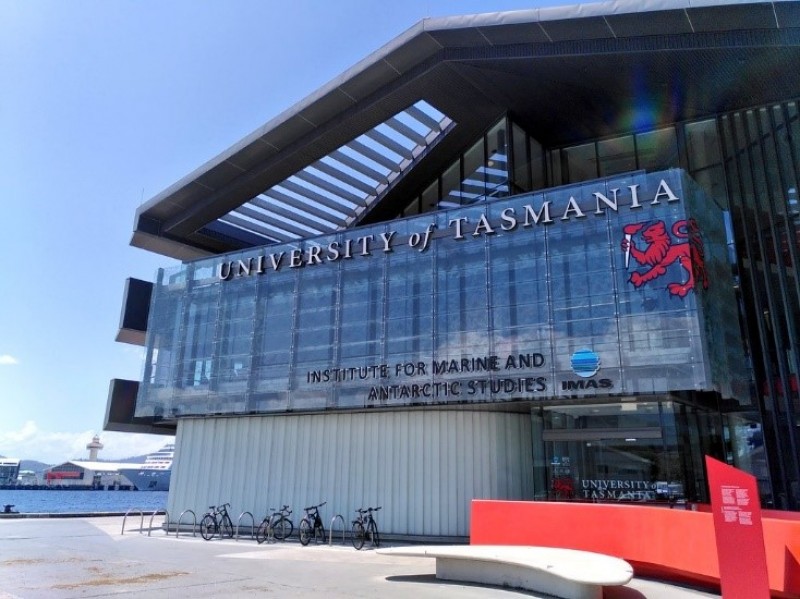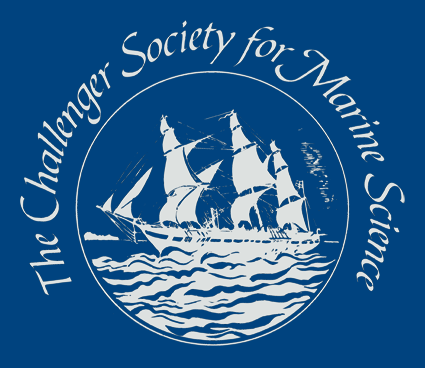A conference in a land down under: the 13th International Temperate Reefs Symposium
Hannah Earp
Aberystwyth University / Newcastle University

Caption: Not a bad place to work - The Institute of Marine and Antarctic Studies at the University of Tasmania, located right on the waterfront in Hobart.
In January 2023 I attended the 13th International Temperate Reefs Symposium (ITRS) in Hobart, Australia, and my attendance was generously supported by a Challenger Society Travel Award. ITRS brings together a global network of marine researchers, including both leading scientists and young researchers, working on temperate hard-bottom environments (e.g., natural rocky reefs, artificial structures, biogenic reefs) for 5-days of presentations, meetings, networking opportunities and informal socialising.
After a long series of flights via Munich, Dubai, and Melbourne, followed by a 17-hour sleep, I was cured of any jetlag and ready for an exciting week of science. The conference began on Sunday afternoon with an informal icebreaker which allowed us to catch-up face-to-face with friends, collaborators, and many new faces for a drink in the sunshine followed by and evening exploring the Salamanca area of Hobart. On Monday, the conference kicked of with a traditional welcome to Tasmania followed by an address by the Governor of Tasmania and an opening plenary. Then the real challenge began – which of the three parallel sessions of talks to attend, there were so many exciting research presentations and keynotes, both from within my field and beyond to choose from. Over the course of the week, we got our steps in running between session to catch presentations by a range of early career and experienced researchers. On the Monday evening we were treated to an evening of canapés at the Tasmania Museum and Art Gallery where we were able network with other conference delegates, explore the exhibits and watch a video about kelp research on Australia’s Great Southern Reef. Based on day one, we knew the rest of the conferences was going to be really enjoyable.
Following another day of exciting talks on Tuesday, it was time for the poster session. I had prepared a poster on my PhD research that investigated the impact of Storm Arwen on kelp forests (Laminaria hyperborea) and their associated understorey assemblages in the NE of the UK. I really enjoyed discussing my research with delegates at the event and immediately felt at ease as everyone was very friendly and eager to learn about what we had found. I was also lucky to win the First Prize Student Poster Award! Wednesday was a more nerve-wracking day as it was my turn to give a talk. My talk was entitles ‘Life of the forest floor: Spatio-temporal variation in Laminaria hyperborea understorey assemblages across the UK’. This was a large piece of work that involved identifying and counting 65,000 macroinvertebrates from over 170 taxa under a microscope. My talk was well received, and I really enjoyed the conversations that followed which included discussions of the distribution of some of the species we observed within Europe, potential drivers of the patterns we observed and presentation styles. The student night that evening rounded off the day well and provided an opportunity to watch the sunset from the rooftop terrace of the Institute for Marine and Antarctic Studies, to eat a lot of pizza, and to hear from established researchers about how to be resilient when even the best planned research doesn’t quite go to plan! During the conference I was also able to meet with collaborators from the Green Gravel Action Group and the Kelp Forest Alliance and we had interesting discussions regarding ongoing collaborations and the future direction of kelp forest restoration efforts. The week flew by and ended with the conference dinner. For this we took the ferry from Hobart to Peppermint Bay, passing by a Macrocystis forest, much to the delight of the many kelp researchers on board. The dinner was made up of a series of mini plates in the garden of the venue which overlooked the beautiful Tasmanian coastline. We then took the ferry back to Hobart and danced the night away with both old friends and new.
Caption: Presenting my research poster investigating the impact of Storm Arwen on Laminaria hyperborea forests and their associated understorey assemblages in the UK.
Overall, ITRS gave me the chance to meet a wide range of researchers from various stages in their career, provided an opportunity to discuss new and future developments in the field of temperate marine research, and provided an insight into opportunities and research collaborations that may be available upon completion of my PhD. ITRS is considered by many as their ‘home conference’ due to the inclusive and supportive atmosphere which is unlike any other conference I have attended previously. I am very grateful to the Challenger Society for their generous support which enabled me to participate in ITRS and I am very much looking forward to the next meeting in France in 2025.

Caption: Giving my presentation on spatio-temporal variation in Laminaria hyperborea understorey assemblages in the UK to a room full of scientists.
Caption: The Moore and Smale research groups enjoying the sunshine (and potentially a glass of wine!) on day one of the conference.
Caption: Time to let our hair down at the conference dinner with a cruise past some kelp forests to Peppermint Bay for a delicious dinner and drinks.
Profile:
I am a final year PhD student at the Institute for Biological Environmental and Rural Sciences (IBERS) at Aberystwyth University and a visiting researcher at the School of Natural and Environmental Sciences (SNES) at Newcastle University. My PhD research ranges from looking at the structure and resilience of kelp forests (Laminaria hyperborea) and their associated understorey communities in the UK, to techniques to restore kelp forests both globally and in the UK. This work has involved fieldwork, lab work and desk-based analyses. During my PhD I have also been fortunate to be involved in international kelp research (Lessonia trabeculata and Eisenia cockeri) trips to Chile and Peru, as well as fieldwork in Wales involving eco-engineering of marine artificial structures.
Latest News
Royal Society Publishing Photography Competition 2025
Please see a message from the Royal Society below:
We are delighted to announce that the 2025 Competition is now open for entries until 15 August for a chance to win £1000! The competition celebrates the power of photography in conveying the wonder of science happening all around us and photographs can be submitted in the categories of: Astronomy, Behaviour, Earth Science and Climatology, Ecology and Environmental Science, and Microimaging.
The competition is free to enter and open to anyone studying or working in science at graduate level or above. Category winners will receive a one-year membership to the Royal Photographic Society and the overall winner will receive a grand prize of £1,000. Find out more: https://bit.ly/RSPphotocomp
October 2025 MEDIN Workshop: Marine Data Management, Governance and the MEDIN toolset
The Marine Environmental Data and Information Network (MEDIN) are pleased to announce that registration is now open for the next occurrence of our popular free online training workshop: ‘Marine Data Management, Governance and the MEDIN toolset’ on the 13th – 17th October 2025 on OceanTeacher Global Academy.
Marine Data Management, Governance and the MEDIN toolset
The Marine Environmental Data and Information Network (MEDIN) and OceanWise are delighted to invite you to attend our popular free online training workshop: ‘Marine Data Management, Governance and the MEDIN toolset’ on the 19th – 23rd of May 2025.
